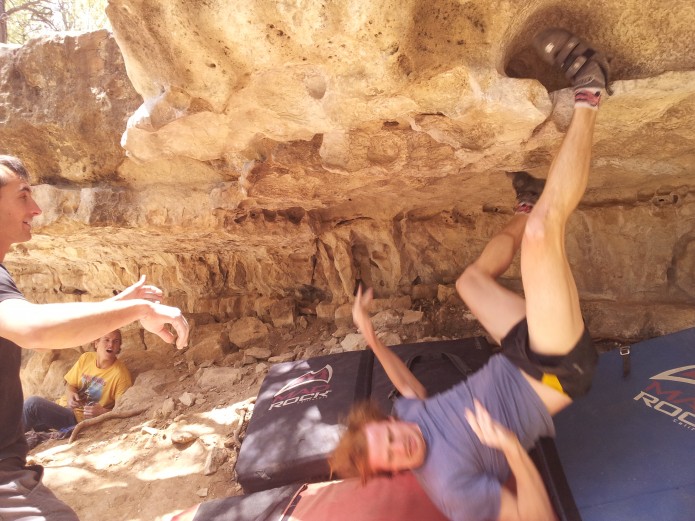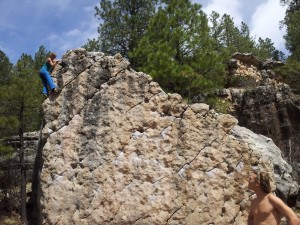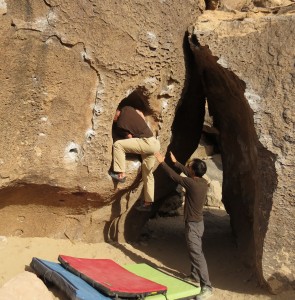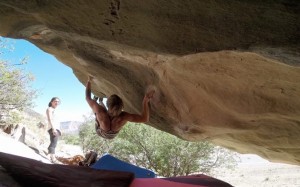Here is a list of slang words/climbing terms that I might use in this blog. To the dismay of some, I did not include anything about alpinism or ice climbing because I will never do those things. I included aid climbing even though I’ll probably never do that because I wanted to clear up the difference between free-climbing and free-soloing. In any case, let me know if you think there is a definition I should include that you do not see below, or if there is something you are curious about, or if you hate me and climbing and everything and I wrote it all wrong and am ruining your life.
Aid Climbing – climbing with mechanical aid such as nails, hooks, bolt ladders as opposed to only using features of the rock to ascend; opposite of free climbing
Bat-hang – hanging from two toe hooks, no hands!
Beta – the specific way in which each person climbs a problem or route; it comes from being filmed with a Betamax camera and watching footage of oneself on a climb; instead of asking, “How do you do this one?” climbers say, “What’s your beta for this climb?”; sounds irritating and pointless but everyone says it and I can’t help it anymore
Bicycle – a move often used on steep overhangs where one foot is toe hooking the rock while the other is pressing against the rock to create a stabilizing effect, much like how you would pedal a bicycle
Bouldering – climbing boulders, usually 10 – 20ft. tall; can be thought of as the sprinting of rock climbing, focusing on harder moves for a shorter period of time vs. sport and trad climbing which are more endurance based
Cam, or to Cam – a cam is a device used in trad climbing (definition below) that functions essentially by expanding against the inside walls of a crack when pulled outwards; basically a chuckwalla cams itself into a crack the same way, by inflating its lungs; it is well known that these lizards are just as safe to whip off of as traditional cams; MORE IMPORTANTLY: moves like heel-toe cams (definition below) are frequently useful for roof climbing (especially at Priest Draw), and that mechanism is what is meant when the word cam is used as a transitive verb, as in, “Cam your toe in that hueco!”

Just tie your rope around this guy, he’s not going anywhere.
to Campus, Campusing – climbing without feet on the wall, as if the holds are monkey bars; frequently used for showing off, but also a useful skill
Campus Board – invented by Wolfgang Gullich this is a ladder of crimp rails mounted to an overhang, and the idea is to campus up them
Chipping – using a chisel or rock, or whatever, to break holds on a boulder, usually done by someone trying to make the problem easier; not an acceptable practice anywhere except on your own private property
Choss – fragile rock that can not be trusted; shitty rock
Crimp – type of hand hold where fingertips are used and the thumb curls over or next to the index finger; basically using the hand as a hook; smaller hands usually excel on crimpier climbs
to Cut Feet – when moving dynamically to a hand hold either by dyno or deadpoint the feet lose contact with the wall and may swing out dramatically; sometimes cutting feet is a necessary part of the beta of a climb, but usually it takes more effort than keeping feet attached to the wall, and can make or break an attempt; can also be done on purpose for fun
Dab, to Dab – a nice word to yell at people while they’re climbing, if done properly achieves same effect as honking a train horn; a dab is accidentally touching the ground, crashpad, your spotter, or anything that isn’t the rock itself while climbing; it casts a shadow of doubt over the whole achievement because there is the possibility that the infinitesimal amount of weight that the dab could have assisted in holding was just enough to let the climber send
Deadpoint – a synonym for “throw” this is a dynamic movement to a hand hold without jumping; sometimes it is difficult to tell the difference between a dyno and a deadpoint, but if the move can be done without cutting feet that usually means it is a deadpoint
Double-Paddle/Clutch Dyno – a huge dynamic move where, in the midst of jumping to one hold, it is necessary to redirect/gain momentum by using an intermediate hold mid-air without pausing on it; I totally know what I’m talking about because I do these all the time, or maybe it’s when you go with both hands.
Drop-knee – a mechanism for bringing one hip closer to the wall in order to reach further with the arm of the same side; that is a really simplified explanation, drop-knees can also help to stabilize the body and keep it closer to the wall so that certain moves can be done statically, or more delicately; drop-knees can also be used as rests on particularly crazy climbs
Dyno – short for “dynamic” this means jumping to a hand hold; opposite of “static”
Ethics – the rules people may follow that are specific to any given climbing area or discipline; trad climbers may have such ethics as, “leave the rock as you found it, don’t place permanent bolts” and sport climbers may have such ethics as, “when placing permanent bolts, you must do it from the ground up and not on rappel” or in Bishop, CA the ethics are never to bolt any free-standing boulder even if it is 60ft. tall and ends up crossing the line between highball and free-solo; Leave No Trace is on the ethics list at every climbing area; also see definitions for chipping and gluing, both questionable on the ethics front
Figure of 4 – an almost decidedly mythical maneuver where the climber hangs one leg over the opposite arm in order to gain enough heighth to reach the next hold; I see this as being in the same category as blinker fluid or muffler bearings. I have climbed a lot of weird things and never come across even one instance of this being useful. Please correct me if I am wrong, use the contact form!
First Ascent (FA) – of course all routes and boulder problems already exist, but the first person to climb each one gets to name and grade it; first ascentionist is the person who does the first ascent
to Flash – successfully climbing a route or problem on the first attempt
Flapper – an injury to the finger where a flap of skin is cut off by a sharp hold; related to “gym flapper” where a callus is ripped off whole
Free Climbing – any type of climbing that relies purely on the climber’s body + the rock; when Lynn Hill “freed” the Nose on El Cap for the first time, that means she was the first person ever to climb the entire route using only the natural features of the rock itself to ascend; opposite of aid climbing
Free-Soloing, Soloing – climbing routes with no rope and no protection; falls are very dangerous and frequently fatal
Gaston – type of hand hold where palm faces away from body, how your hands would be if you were trying to pry open elevator doors; opposite of sidepull
Gluing – when a necessary hold on a problem seems like it may break soon, or has already broken, someone may glue it onto the wall; the ethics of this are more ambiguous than chipping, since the hold had naturally formed on the boulder in the first place, but it is still kind of taboo; I am totally ok with it as long as it is done somewhat inconspicuously
Heel Hook – very common move where the climber uses the heel to pull on a hold in the rock
Heel-toe Cam – shoving a foot into a hole the rock so it gets stuck and offers support; frequently used in roof climbing; can be scary because if the climber falls it can feel like the foot might stay jammed in the rock and break off of the leg
Highball – a boulder that is very tall and, if not dangerous, at least very scary at the top; usually 20ft.+
Hueco – means “hole” in Spanish, used to describe crater-like depressions in rock such as the ones found in Hueco Tanks, TX; can be any size or shape, but picture a toilet bowl, the rim is used as a hand hold and can be a jug, edge, crimp, sloper, pinch, or any other kind of hold depending on the shape of the hueco
“I have it in two halves” – generally referring to boulder problems this means that the climber has done the first half of the climb and the last half of the climb separately and just needs to muster the endurance to link the two halves in one attempt to send the problem
Jug – giant hand hold, like an oasis in a desert
Kneebar – climber fits bottom half of leg into a rock feature so that flexing of the foot presses the top part of the thigh into the rock in order to create enough friction to keep the climber on the wall; most of the time kneebars provide a rest opportunity for the climber (double kneebars being the holy grail with room for both legs to kneebar), but there are times when kneebars are a necessary in order to gain the next hold, and do not offer a rest at all
Leading – when sport or trad climbing the climber brings the rope their harness is tied into up the wall with them and clips it into protection in the rock whether permanent or temporary; opposite of toproping; considered necessary for the redpoint of routes, as someone else has to set up a toprope
Lowball – very short boulder problem, not usually a dangerous fall potential, sometimes frustrating dab potential; tongue in cheek opposite of highball, not usually the most “aesthetic line”
Mantle – a move where the climber must end up pushing down on a hold; frequently to top out a boulder the climber must mantel; can be thought of as how one would get out of a pool: throw a heel up on the edge, pull up with the hands, and then push down until the foot is weighted more than the hands
to Match hands/feet- putting both hands or feet on the same hold, sometimes just to switch them out
Midnight Lightning – the most famous boulder problem in the world, supposedly the standard for v8, but now considered sandbagged because the V-scale got away from Mr. V, and has a life of its own now
to Onsight – sending a route or problem on the first attempt without having seen or heard anyone else’s beta
Pinch – type of hand hold grasped between fingers and thumb, kind of self-explanatory
Pocket – type of hand hold where 1-3 fingers go into a hole in the rock
Problem – any climb (or route) on a boulder; alludes to the math-like property of bouldering wherein each “problem” has a specific solution or whatever, I don’t know why we can’t just call them routes or climbs, or even puzzles, it sounds ridiculous
Pumped, Pumpy – the feeling of extreme fatigue in the forearm muscles, frequently brought on by use of slopers and jugs; pumpy is used to describe a climb that is tiring for the fingers
to Punt – falling off a boulder problem after you’ve already gotten through the crux; frequently self-inflicted because sending is scary or maybe the boulder is tall, or maybe you are just a gross little baby
to Redpoint – sending a boulder problem or a route on lead on any attempt after the first
Roof climbing – climbing on terrain that is so overhung that it is horizontal or almost horizontal; my most favorite type of climbing; frequently done in caves but Priest Draw in Flagstaff, AZ is considered the Mecca of roof climbing; should be called “ceiling climbing” because climbing roofs is easy, just walk on the roof
Fun activity: Find examples of sending, roof climbing, bicycling, cutting feet, and a mantle in the video below!
Sandbagged – when a problem or route is hard for the grade; can refer to entire climbing areas, Joshua Tree is notoriously sandbagged for example, and it mainly happens to older crags, after more generations of bro-y climbers have downgraded problems over the years
to Send, Sending – climbing a route or problem “clean” from start to finish, without falling or letting the rope or any item (besides the rock) take any of the climber’s weight; the holy grail of climbing
Send Temps – COLD. Too cold for us. Rock tends to sweat when it’s hot or in direct sunlight, and friction is compromised. If you are serious about sending a project that is very slopey, you might want to wait until it is in the shade or until winter for example.
to Session, sessioning – surely this is not specific to climbing, but it just means working on a boulder problem for a period of time
Sidepull – type of hand hold that is facing away from the climber; opposite of gaston
Slab – a wall that is slightly less than vertical and as a result much smaller holds can be used if one has good balance, technique, and trusts their foot holds; lead falls on this terrain result in a cheese-grater type experience
Sloper – type of hand hold, frequently boob-shaped, considered the opposite of a crimp; whole hand including palm can be in contact with hold and bigger hands tend to prefer slopers over crimps
Soft – when a problem or route is easy for the grade, or in competitions, easy for how many points it is worth
Sport Climbing – climbing walls with permanent bolts in the rock so the climber doesn’t have to carry trad gear for protection (such as cams or nuts) and can focus more on climbing and less on their own imminent death
Spray – any way in which a climber brags whether it be yelling beta at someone climbing, linking their Sendage or 8a.nu scorecards to Facebook, posting videos of themselves climbing, etc…. basically this blog is a Spray Factory!
Static – reaching in a controlled fashion for a hand hold as opposed to throwing or jumping to it; generally takes more strength to do certain moves statically, but dynos look cooler and can be more fun at times
Threader – a hold created by a hole that goes all the way through the rock
Toe Hook – using the top of the foot to pull against the rock; basic element of bicycles and bat-hangs
to Top Out – getting on top of a boulder, cliff band, or cave; how all the best problems are finished
Toprope, Toproping – the rope is already through the anchors at the top of a route so the climber doesn’t have to do anything with the rope while climbing; results in much smaller falls than leading and is used when the climber is afraid, doesn’t know how to lead, or is simply practicing the moves in preparation for their redpoint attempt
Trad Climbing – “traditional” climbing where the climber carries a rack of gear up the wall with them (such as cams and nuts) to place in features of the rock temporarily as protection, and it is removed at the end of the climb, leaving the rock in its natural state (minus pin scars and blown out chunks where gear blew, you know, whatever)
Walking – making a climb look ridiculously easy; used in a sentence: “So I was sessioning the crap out of this problem and Chris Sharma just comes up and walks it as part of his warm-up.”



